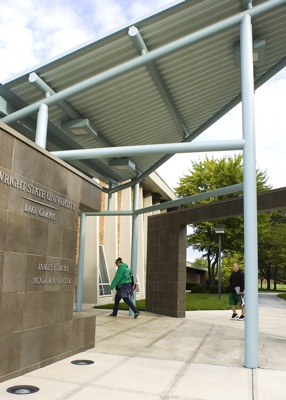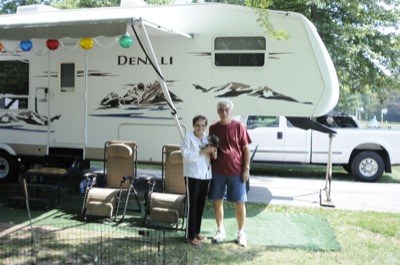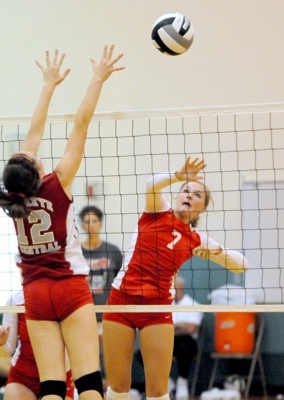Tuesday, September 6th, 2011
Peat found during lake core sampling
Company says product could be used to make potting soil from muck
By Nancy Allen
GRAND LAKE - Core samples of Grand Lake's muck preliminarily show a lot of peat at the lake's bottom, but not much sand.
The state last week sent 60 core samples for analysis to determine if there is a market for the nutrient-rich mud. Dredging the muck is one of several measures under way to help improve the lake's water quality.
"In the middle of the lake, we've got miles and miles and miles of peat," dredge supervisor Tom Grabow told members of the Lake Improvement Association during a meeting Saturday. "What we've got is a layer of sediment and then peat, so that tells me that's the original lake bottom when it was a swamp."
Peat, or turf, is an accumulation of partially decayed vegetation matter that forms in wetland bogs and swampy areas. It's used as a soil additive to improve its structure and ability to hold moisture and nutrients.
The peat may be attractive to owners of a Wisconsin company who recently announced they want to build a plant near the lake that turns dredged lake sediment into potting soil. One of the needed additives is some sort of fibrous material, such as peat.
Paul Chadwick, marketing director of Amiran Technologies, this morning said the peat could be used in the company's proposed potting soil production facility.
"Some of this fibrous material we would have to import, and we've checked sources in Canada and others," Chadwick said. "But if there is an abundance there in Ohio, that could be positive."
Lake officials also thought the muck may contain an abundance of sand, which could be marketed to the construction industry.
A consultant "thought there was going to be all this sand, but it just wasn't there," Grand Lake St. Marys State Park Manager Brian Miller said. He said sand was in one small area in the center of the lake, while the peat was all over the lake.
Miller said the core sampling and analysis cost $50,000 and is being paid for by the state. A second phase may entail even more analysis, but no cost estimate was available.
A unit called a vibracor was purchased for $17,140 to take the samples. It was paid for from the state park's dredging budget.
Leading the core sampling work was state-hired consultant David Jahn of DWJ Resources of Signal Mountain, Tenn. He was recommended by the Ohio Aggregates and Industrial Minerals Association and said he was interested primarily in the sand for making concrete.
Also at the LIA meeting Saturday, Grabow reported the state will start its annual stump removal on the lake the end of this month or early next. Residents who know of submerged stumps, logs or other objects are asked to mark them with floating plastic jugs tied to string and notify state park workers of the location.
The state in October will bring in a stump grinder to make mulch from an accumulation of stumps at the state park office. The mulch will be used for state projects.
The state has dredged 185,210 cubic yards of sediment from the lake this year. The goal is 200,000 cubic yards, Grabow said.
The week after the Governor's Cup Regatta the lake water sample produced the highest microcystin algae toxin levels of the summer, Miller reported. This is the third consecutive summer the state has measured algae-toxin levels and issued a water advisory for the lake.
"We had levels ranging from 12.6 parts per billion to greater than 50 last week," Miller said Saturday. "The week prior to the Governor's Cup, they ranged from 4.8 to 18.3."
Miller reminded the public to avoid areas of the lake with algae blooms.
"You see a surface scum that looks like paint, stay out of it, keep your dog out of it because that's a highly toxic area," he said.
Also at the meeting, LIA members:
• Observed a moment of silence for member Vic Woodall who died recently. Woodall was credited with bringing the lake's water quality problems to the public forefront in recent years.
"When I think of Vic, I think of one word, 'courage'," said former LIA President Bill Ringo, noting Woodall and other LIA members got thrown out of some meetings because the crowd disagreed with their message. "He had the courage to bring issues of the lake to the public and that was like messing with people's belief system."
• Learned volunteers are needed for the annual fishing derby for developmentally and physically challenged adults and children on Sept. 14 Volunteers would serve food, bait hooks, take fish off and bake cookies for those attending. Last year, 371 special needs children and adults and their chaperones attended. The event is at East Bank shelterhouse No. 1 near the pond.
• Learned the lake's water level is at normal pool, meaning it is even with the notch at the West Bank spillway.
• Were told nominations are still being accepted for the LIA's annual Guardian of the Lake award.



